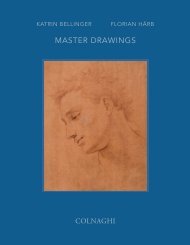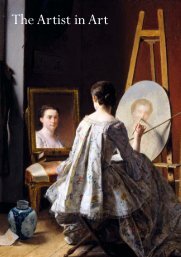2007 Catalogue - Colnaghi
2007 Catalogue - Colnaghi
2007 Catalogue - Colnaghi
Create successful ePaper yourself
Turn your PDF publications into a flip-book with our unique Google optimized e-Paper software.
Provenance: Anon. Sale; Paris, 24 December 1821, lot<br />
10, as 'Intérieur d'appartement offrant le sujet de deux<br />
jeunes personnes occupées à la lecture d'une lettre',<br />
(Possibly) Général Ribourt. Sale, Drouot, Paris, 25 -<br />
26 March 1895, lot 21; Muhlbacher. Sale, Paris, 14<br />
May 1907, lot 28, erroneously states that the painting<br />
was exhibited in the Salon of 1806; Seligmann<br />
collection, 1937; Anon. Sale, Galerie Charpentier,<br />
Paris, 10 June 1954, lot 28; Bruni-Tedeschi collection.<br />
Literature: S. Wells-Robertson, Marguerite Gérard,<br />
unpublished dissertation, New York, 1978, II, pt. 2,<br />
p. 846, no. 70a.<br />
Exhibited: Salon du Louvre, 1806.<br />
Born in 1761, Gérard moved to Paris in 1775 where<br />
she lived with her sister Marie-Anne and her sister’s<br />
husband Fragonard in their quarters in the Louvre. She<br />
became his protégé and may well have collaborated<br />
with him in the 1780s (see First Steps of Childhood,<br />
circa 1780-83; The Fogg Art Museum, Cambridge,<br />
MA). She lived for the next 30 years in the Louvre,<br />
where she was able to study masterpieces of art – an<br />
important factor given that, as a woman, she was<br />
deprived of an academic training. While Fragonard's<br />
tutelage was important to her technical development,<br />
it was her interest in Dutch masters of the 17th century<br />
that truly characterized her work. It was from these<br />
"conversation pieces" that she drew inspiration for her<br />
sentimental themes and learned to indulge in<br />
meticulous detail. While her canvases record the<br />
privileged and secluded lives of educated women of her<br />
own time, they also look forward to the domestic genre<br />
scenes that became so popular later in the nineteenth<br />
century. By 1785, she had become a respected genre<br />
painter, the first French woman to do so, and,<br />
alongside artists such as Vallayer-Coster and Vigée-<br />
Lebrun, was one of the leading women artists in<br />
France. An accomplished portrait painter, she was a<br />
regular contributor to the Salon from 1799 to 1824,<br />
after the restriction on women exhibitors was lifted.<br />
Her work was further popularized through engravings.<br />
24<br />
Marguerite Gérard<br />
(Grasse 1761 – 1837 Paris)<br />
La Bonne Nouvelle<br />
Signed lower left: Mle gérard<br />
Oil on panel<br />
25 5 /8 x 21 1 /8 in. (65.1 x 53.7 cm.)<br />
74<br />
This painting and indeed Le Petit Messager and<br />
La Chat Angora, both presently with <strong>Colnaghi</strong>, are<br />
typical of the types of paintings that the artist exhibited<br />
around the nineteenth century depicting the idealized<br />
private world of bourgeois women.<br />
The <strong>Colnaghi</strong> painting is one of three known versions<br />
of this subject painted by Marguerite Gérard. 1 Three<br />
versions are recorded by Sarah Wells-Robertson: 2 a<br />
painting on canvas that was exhibited at the Salon of<br />
1804 (Robertson, no. 70, 62 x 51 cm.); the <strong>Colnaghi</strong><br />
version on panel (Robertson, no. 70a, 64 x 53 cm.);<br />
and a smaller version on canvas (Robertson, no.70b,<br />
26 x 20 cm.).<br />
Our painting is unmistakably the second version of the<br />
1804 Salon picture. It has the differentiating<br />
characteristics mentioned by Robertson - the bow on<br />
the bodice worn by the lady standing and the swept<br />
back fringe of her hair. This painting also dates to<br />
1804, at which time Robertson describes Gérard as,<br />
"at the peak of her career, and the Grande dame of<br />
French genre painting". She also notes that "La Bonne<br />
Nouvelle is a quintessential example of the Gérardian<br />
genre picture”. 3 La Bonne Nouvelle depicts two wealthy<br />
young women reading a letter amidst sumptuous<br />
surroundings of a boudoir, the viewer is left to<br />
interpret the content, perhaps with romantic inuendos.<br />
The restrained interior scene is enlivened by the<br />
narcissistic spaniel admiring himself, and his blue<br />
ribbon, in the mirror. While it is true that animals<br />
often had an overt symbolic function in seventeenthcentury<br />
works, in our picture the spaniel adds a jovial<br />
touch to the scene. Gérard’s figures are enclosed in a<br />
safe and sealed world. It is an environment, elegant and<br />
refined, that she constructs from familiar motifs drawn<br />
from earlier sources and yet rearranges quite uniquely<br />
to create a world that is all her own.








